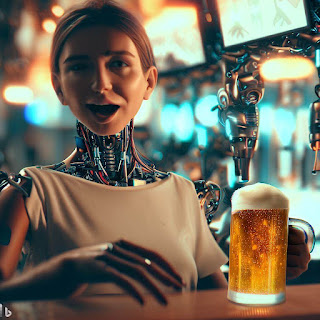Beer commercials are usually meant to be fun, catchy, and appealing to the target audience. They often feature attractive people, catchy slogans, and scenes of socializing and enjoyment. But what if beer commercials were created by artificial intelligence (AI) instead of human creativity? Would they still be fun, catchy, and appealing? Or would they be weird, creepy, and disturbing?
 |
| AI-Generated Beer Commercials |
{getToc} $title={Table of Contents}
That is the question that some people have been asking after watching
some viral videos of AI-generated beer commercials that have been circulating
on social media. These videos were created by a London-based production company
called Privateisland.tv, using a new AI model called Gen-2 from Runway, a
platform that allows anyone to create and edit media using AI.
How Gen-2 Works
Gen-2 is an AI model that can generate short video clips based on
written prompts, similar to how Stable Diffusion can create still images. The
model was trained on a large dataset of images and video clips, and it uses a
technique called generative adversarial networks (GANs) to produce
realistic-looking media.
However, Gen-2 is still a very new and experimental model, and it has
many limitations and challenges. For one thing, it can only generate a few
seconds of video at a time, and the quality and coherence of the output depend
on the input prompt and the randomness of the generation process. Moreover, the
model does not have a good understanding of the real world or the context of
the media it is creating. It often produces distorted, deformed, or unrealistic
images and scenes that do not make sense or match the intended message.
Synthetic Summer: A Surreal AI-Generated Beer Commercial
One of the most popular examples of AI-generated beer commercials is
Synthetic Summer, a 30-second video that was posted on Instagram by
Privateisland.tv about a week ago. The video shows a simulated backyard
barbecue party where people are drinking beer from blue cans and bottles. The
video is set to the song “All Star” by Smash Mouth, and it has a cheerful and
upbeat tone.
However, upon closer inspection, the video reveals many bizarre and
unsettling details that make it look like a hallucinogenic nightmare. The
people in the video have distorted facial features, such as extra eyes, mouths,
or fingers. Some of them merge with the beer containers or each other in
unnatural ways. The fire from the grill becomes a raging inferno that engulfs
the whole scene. The video ends with a slogan that says “Beer: It’s Good”.
The video has received mixed reactions from viewers, with some finding
it hilarious, creative, or impressive, while others finding it horrifying,
disturbing, or offensive. Some have compared it to a horror film or a bad trip.
Some have questioned the ethics and implications of using AI to create such
content.
Pepperoni Hug Spot: Another AI-Generated Commercial Gone Wrong
Beer is not the only product that has been advertised by AI in a weird
and creepy way. Another viral video that was posted on Twitter by someone
called Pizza Later shows an AI-generated commercial for a fictional pizza
restaurant called Pepperoni Hug Spot.
The video uses After Effects to combine several clips generated by
Runway’s Gen-2 model based on written prompts. The video has a digital-sounding
narrator that says “Are you ready for best pizza of life? Bring friends down to
Pepperoni Hug Spot”. The video then shows various scenes of people eating pizza
with distorted faces and expressions. The pizza itself looks unappetizing and
unnatural. The video ends with a slogan that says “Pepperoni Hug Spot: It’s
Good”.
The video has also received mixed reactions from viewers, with some
finding it funny, absurd, or ingenious, while others finding it disgusting,
scary, or insulting. Some have commented on the poor quality and taste of the
pizza or the restaurant name. Some have wondered what the purpose or message of
the video is.
The Future of AI-Generated Commercials
AI-generated commercials are not meant
to be taken seriously or literally. They are more like experiments or jokes
that showcase the possibilities and limitations of AI technology. They are not
intended to replace human creativity or judgment in creating effective and
ethical advertising.
However,
AI-generated commercials also raise some important questions and challenges for
the future of media and marketing. How will AI affect the production and
consumption of media content? How will AI influence the perception and behavior
of consumers? How will AI impact the ethics and regulation of advertising? How
will AI interact with human creativity and collaboration?
These are some of the questions that need to be explored and addressed as AI technology advances and becomes more accessible and powerful. AI-generated commercials may be a new trend or a nightmare, but they are also a window into the future of media and marketing. They show us what AI can do, but also what it cannot do, and what we need to do as humans to ensure that AI is used responsibly and beneficially.
